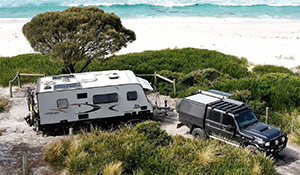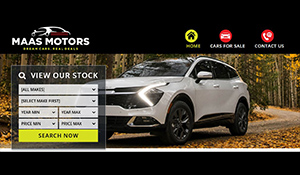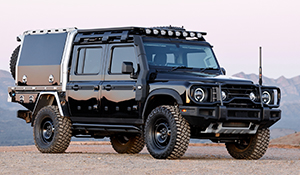FEATURE- 1966 Ford Bronco Dune Duster
Words: Mike Ryan
Photos: Ford Media
George Barris is a name that should need no introduction to the JUST CARS audience. Thanks to his work producing the original Batmobile, Munsters’ Koach and Beverly Hillbillies truck, along with countless customs for individual and celebrity customers, he was a legend in the custom car community.

While those aforementioned creations are known worldwide, the recent release of the all-new Ford Bronco saw a lesser-known Barris creation return to the spotlight – the Dune Duster.

Goin’ Off Road
Ford’s original Bronco had been produced for the 1966 model year in response to the growing “recreational” four-wheel drive market. Since the end of World War II, Jeep had this market to themselves, but the arrival of the International Scout in 1961, and its popularity, led to Ford seeking a slice of that market, too.
Described as a “sports utility vehicle” decades before the SUV term became commonplace, design work on the Bronco began in 1963, with the styling, dimensions and standard features, like the solid axles and dual range four-wheel drive, being very much in the mould of its competitors.

Aimed at the growing youth market, like the Mustang, the new Bronco would be compact, with a short wheelbase, spartan interior and minimal standard appointments, but a range of factory options.
Where the Bronco had the jump on its rivals was the versatility of the basic body design, which was offered as a two-seat open roadster, compact utility/pickup and a wagon. Ford also offered a V8 engine, the proven 289, which its rivals didn’t have at the time (International introduced a V8 Scout in 1967, but a V8-engined CJ Series Jeep wouldn’t arrive until 1972). Although a 170ci six-cylinder was the only engine available initially, the small block V8 was added within six months of the Bronco’s introduction and soon became a popular option.

Coil spring front suspension was an oddity for a four-wheel drive back then, as was a column shift manual transmission, but Ford billed the latter as a positive, freeing up more passenger space. More conventional – and off-road suitable - equipment included a Dana 20 transfer case, Dana 30 front axle and the familiar 9-inch diff.
Even before its launch in September, 1965, Ford were confident that the Bronco would be successful in a market segment that they claimed had grown more than 360 per cent in four years.
To help ensure that success, Ford’s promotional machine was kicked into overdrive, which was where Barris came in.

Bling for the Bronco
When the Bronco was launched, custom cars were hot stuff, so it made sense to have a customised version doing the rounds of the US motor shows. Ford already had a good relationship with George Barris, so he and the team at Barris Kustom were the logical choice to produce the show car, which would be called the ‘Dune Duster’ to cash in on the then-current dune buggy craze.
As a sidenote to this, Ford’s PR previewing the Bronco’s launch stated that “teenagers have invented a new sport for four-wheel drive vehicles, using them to drag race in loose sand”. Maybe this thinking influenced the Dune Duster’s design and its name.

Unlike most Barris creations that preceded and followed, the Bronco Dune Duster would only be built by the North Hollywood custom shop – the vehicle was designed in-house at Ford’s Styling Centre.
Using a new Bronco roadster as its base, modifications were made with a view to preserving the Bronco’s identity, but adding some fun features.
Starting with special Golden Saddle Pearl paint, the Dune Duster exterior also featured woodgrain applique panels on the rear flanks, with the Bronco script badges normally found on the front guards moved to this position. Woodgrain also featured on the tailgate, which remained functional, while the rear bumper was trimmed with big rubber overriders.

The front bumper added similar chunky rubber blocks, while the grille was partially chromed, with the rest painted in a contrasting colour to the body.
Like the factory Bronco roadster, the Dune Duster used fiberglass door inserts, but these were of a different shape on the show car and incorporated a step into the design for easier vehicle entry, as well as leather upper trim and a grab handle.
Another standout feature was the roll bar. Ford’s PR of the time described it an NHRA (National Hot Rod Association)-approved item, which meant it could feasibly protect occupants in the event of a rollover. Headrests were incorporated into this bar, while its shape was replicated in a rounded treatment to the windscreen frame that was trimmed in chrome.

What sort of drivetrain the Dune Duster ran is unrecorded. While a custom bonnet scoop, side-exit exhausts and heatshields suggested something potent, it’s most likely that the humble 170 Six powered the show car, especially given the fact a V8 version of the production Bronco was still several months away. What was changed was the gear shifter for the 3-speed manual transmission, moved to a floor-shift from the standard column-shift position.
Inside, the front bucket seats (a factory feature) were trimmed in a mix of russet suede on the bolsters and perforated leather for the squabs and seatbacks. Suede trim also featured on custom-made padded dash protectors, while red carpet lined the floor. The woodgrain theme from the outside was continued with walnut-trimmed control knobs and a walnut-rimmed, GT-style steering wheel.

Small, leather-trimmed jump seats were added to the cargo area, incorporated atop the wheel tubs and including lap seat belts, while the rest of the cargo area was lined with red carpet and fitted with walnut skid strips.
Other features included a racing-style fuel cap, dual sports-style mirrors, chrome trim on the dash, chrome side rails, a removable fabric hood and side curtains, a button-down vinyl tonneau cover and custom-made alloy wheels with faux knock-off hubs.

Duster to Flower
The Bronco Dune Duster made its debut at the Detroit Auto Show in November, 1965, and continued on the car show circuit through 1966. It was removed from service after that tour and, presumably, went back to either Ford or Barris Kustom.
Four years later, the Dune Duster reappeared, but this time it looked very different!

In late 1970, flower power was in full effect, so the Dune Duster was reimagined as the ‘Wildflower’. Essentially, it was the same vehicle, but repainted in appropriately psychedelic patterns (including a pink grille!), while the seats had been retrimmed in white vinyl with floral pattern inserts.
Changes in the trim on the doors and the roll bar’s headrests were also applied. The woodgrain trim was gone, along with the side mirrors and badging, but familiar features from the Dune Duster version, like the wheels, side exit exhaust, fuel cap and chromed grille, were unchanged.
Ford again were responsible for the design, with Barris Kustom presumably doing the work.
The Wildflower gained much less publicity than the Dune Duster, and after its turn on the show circuit in 1970-71, it disappeared off the radar. Its whereabouts are unknown today.









